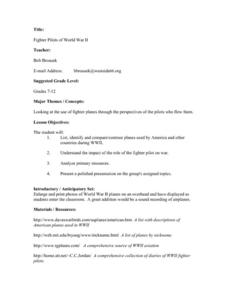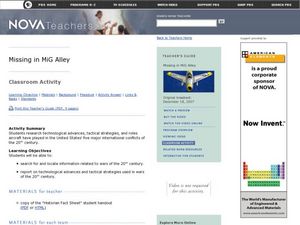Teach Engineering
Fun with Bernoulli
Reduce the pressure in the classroom. The second instructional activity in an Airplanes unit of 22 introduces the class to Bernoulli's Principle. Pupils demonstrate the principle by blowing between different objects causing a reduction...
Curated OER
Paper Airplanes
Students study paper airplanes. In this instructional activity on aerodynamics, students print out the folding directions for making paper airplanes and after making the planes test their paper airplanes to see how well each flies....
Curated OER
Criteria and Constraints in Aircraft Design
Students investigate criteria and constraints for designing any aircraft. They define these terms and categorize a series of examples of both. Using the constraints and criteria set before them, they design and construct airplanes in...
Curated OER
Fighter Pilots of World War II
Learners explore the types of airplanes that were used in World War II. In this World History lesson, students write a research paper that compares and contrasts three types of American airplanes and three types of foreign...
Curated OER
The Wright Brothers on Hollywood Squares
Students test their knowledge of the Wright brothers by playing "Hollywood Squares." They read (or listen) with comprehension. Students follow the rules as they actively participate in a game to test their reading (or listening)...
Curated OER
Missing in MiG Alley
Students consider how technology impacted American conflicts. In this technological advances instructional activity, students read, "The Changing Face of War," and then describe how technology made differences in World War I, World War...
Curated OER
Banana Man Glider
Learners incorporate technology into the classroom as they investigate force and motion. For this science lesson, students construct a glider to be able to safely take a banana to the ground without dropping it. They investigate flight,...
Curated OER
Science: Flight Aerodynamics
Students apply the principles of aerodynamics by constructing styrofoam airplanes. By using simple tools and materials, they improve their spatial visualization abilities while increasing motor skills. After small groups of students...
Cornell University
Catapults
Ready, aim, fire! Launch to a new level of understanding as scholars build and test their own catapults. Learners explore lever design and how adjusting the fulcrum changes the outcome.
Curated OER
Key Ingredients: America by Food
Learners participate in a series of activities to explore the types of food Americans eat, how food choices differ in various parts of the country, and how the availability of various foods has changed over time.
Curated OER
Key Ingredients: America By Food
In this set of five lessons, students analyze the important of food traditions, identity, and history. Students analyze how food traditions contribute to family identity, investigate family food traditions through interviews, and compare...
Teach Engineering
Projectile Magic
What do the movies October Key and Harry Potter and the Sorcerer's Stone have in common? The fourth installment of a five-part module presents equations regarding projectile motion and how to rearrange them. Scholars view video clips...
Curated OER
FLY to Success
First graders are asked how they can improve their skills. They are told how they can do better at following directions. Students identify what they need to listen for. They determine the skills needed to get along with others.
Curated OER
From Future Flight to Past Flight
Students complete a set of CD-ROM's to introduce them to the flight program at NASA. In groups, they research a topic related to flight and put their information on a CD-ROM. To end the lesson, they share their material with other...
Curated OER
Technology and the Great Depression
Pupils examine how technology affected the Great Depression era. They view a video, conduct Internet research, and write articles for a class technology magazine.
Curated OER
A Real-Life Application of Ratio
Students discuss the concept of "aspect ratio" of the Helios Prototype. They find real life objects that are taller or shorter than them by a certain amount. They practice with ratio and measurement.

















